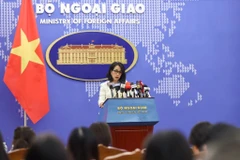VNA and provincial People's Committee leaders attended the name plate attaching ceremony of Tran Kim Xuyen and Dao Tung streets, made in recognition of their substantial contributions to the country’s revolutionary press.
Tran Kim Xuyen street, located in TanTien commune, is 0.56km long and 7.5m wide and has two 4.5m-wide pavements. Meanwhile,Dao Tung street in Tan My commune is 1.18km long and 12m wide and has two6m-wide pavements.
Xuyen (1921 - 1947) was bornin Son My commune of Huong Son district, the central province of Ha Tinh. In August1945, he was appointed head of the Office of the then Ministry of Communicationsand Deputy Director of the then Vietnam Information Department in charge of theVNA. On January 6, 1946, he was elected a deputy of the first-tenure NationalAssembly for the area of Bac Giang. He laid down his life in Ngoc Son communeof Chuong My district, Ha Tay province (now Hanoi), on March 3, 1947, whileevacuating documents. Xuyen was the first Vietnamese journalist and also thefirst VNA member to fall down during the resistance war against the French colonialists.
The hometown of Dao Tung (1925 - 1990), real name Do Trung Thanh, was the fomerPhu Lang Thuong (Lang Thuong district) of Bac Giang province. He served as Editor-in-chiefof the VNA from May 1966, and then General Director and Editor-in-chief of theVNA from 1977 until his death. He also used to serve as Vice President of the InternationalOrganisation of Journalists, member of the Vietnam Fatherland Front CentralCommittee, Vice Chairman of the National Assembly’s Committee for External Relations,and Vice Chairman of the Vietnam - Cambodia Friendship Association. He wasgranted the second-class Independence Order, the first-class Resistance WarOrder, and many other noble rewards by the Party and State in recognition ofhis dedications.
 The ceremony attaching the name plate of Dao Tung street in Bac Giang city on September 8. (Photo: VNA)
The ceremony attaching the name plate of Dao Tung street in Bac Giang city on September 8. (Photo: VNA)
In her remarks, VNA General DirectorVu Viet Trang said the ceremony demonstrated the gratitude from the Party, the State,the local admininistration and people, and the VNA to Tran Kim Xuyen and DaoTung, who were typical examples of the journalists - soliders making enormouscontributions to the fight for national liberation and Vietnam’s revolutionarypress.
That the streets were named afterthem also showed the recognition of the VNA’s contributions, she said, notingthat during resistance wars, its reporters and technicians were present acrossbattlefields and surmount all hardships to fulfill their duties.
Nearly 260 reporters and techniciansof the VNA laid down their lives for the Fatherland, the officialwent on.
With 2,100 staff members, includingover 1,200 reporters and editors nationwide and around the world, the VNA isupholding its traditions, unceasingly making reforms and innovation, andapplying modern technology to maintain its stature as the strategic andtrustworthy information centre of the Party, State and people and move forwardson the path to become the key multimedia news agency of the country, accordingto the General Director.
So far, seven streets across Vietnamhave been named after VNA journalists. They include three named after Tran KimXuyen – in Cau Giay district of Hanoi, Pho Chau township of Ha Tinh province,and Bac Giang city of Bac Giang province. The others are Bui Dinh Tuy in Ho ChiMinh City, Lam Hong Long in central Binh Thuan province, Tran Binh Khuol insouthern Bac Lieu province, and Dao Tung in Bac Giang./.






























